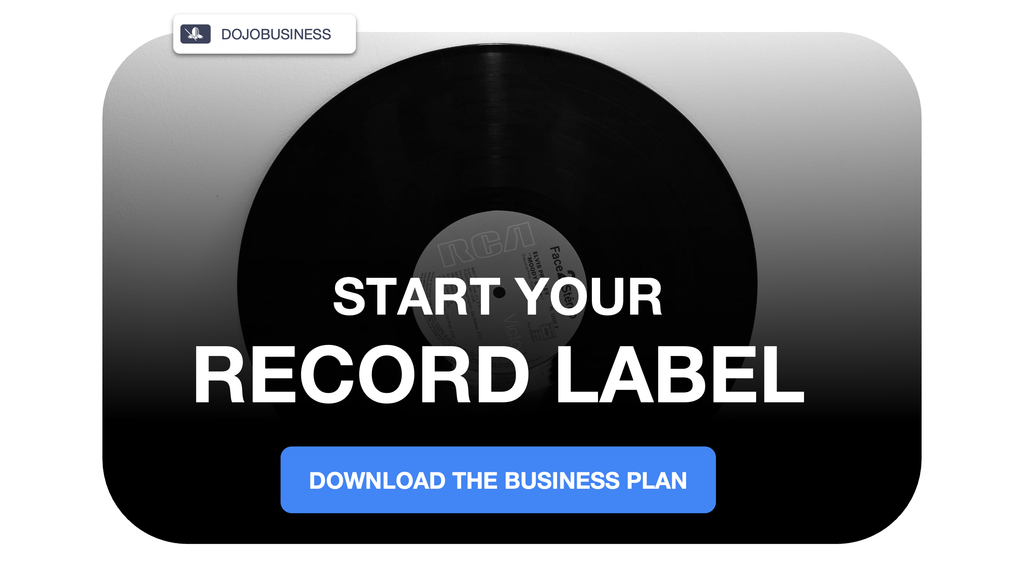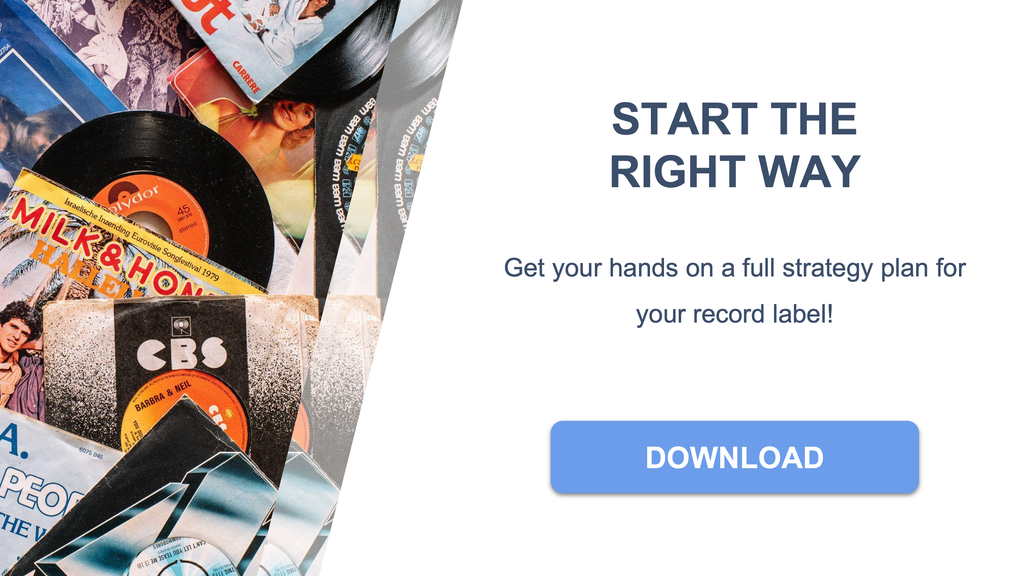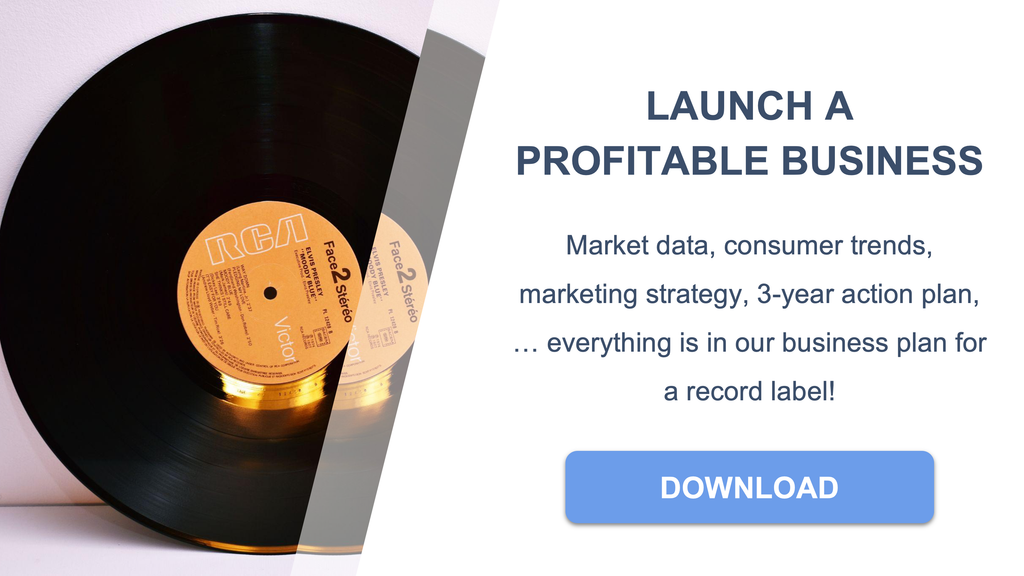This article was written by our expert who is surveying the industry and constantly updating the business plan for a record label.

Starting a record label requires strategic planning and financial discipline to succeed in today's competitive music industry.
Independent record labels face unique challenges including limited budgets, artist acquisition costs, and navigating complex distribution deals while building sustainable revenue streams. Success depends on understanding legal requirements, managing cash flow effectively, and implementing targeted marketing strategies that deliver measurable returns on investment.
If you want to dig deeper and learn more, you can download our business plan for a record label. Also, before launching, get all the profit, revenue, and cost breakdowns you need for complete clarity with our record label financial forecast.
Creating a profitable record label requires initial capital of $20,000-$50,000, proper legal structure, and diversified revenue streams beyond music sales.
Independent labels typically achieve profitability within 18-24 months by maintaining lean operations, securing favorable distribution deals, and focusing on niche genres with dedicated fanbases.
| Key Element | Requirements | Expected Costs/Timeline |
|---|---|---|
| Legal Structure | LLC or Corporation registration, trademark protection, business licenses | $2,000-$5,000, 4-8 weeks setup |
| Startup Capital | Equipment, marketing, artist development, operating capital | $20,000-$50,000 minimum viable budget |
| Core Team | A&R, marketing/PR, distribution manager, legal counsel | 2-4 people initially, outsource specialists |
| Distribution Strategy | Digital platforms, physical distributors, direct-to-fan sales | 15-30% revenue share to distributors |
| Revenue Streams | Streaming, publishing, merchandise, live events, sync licensing | Multiple income sources reduce risk |
| Artist Royalties | Competitive splits, transparent reporting, recoupable advances | 10-20% to artists, 50/50 for established acts |
| Break-even Point | Consistent monthly revenue covering all costs | 18-24 months with proper management |

What is the exact legal process and structure required to register a record label?
Registering a record label requires choosing an appropriate business structure, completing government filings, and securing industry-specific licenses and protections.
The first step involves selecting between LLC or corporation status, with LLCs offering flexibility and pass-through taxation while corporations provide stronger liability protection and easier investor access. Most independent record labels choose LLC structure for its operational simplicity and tax advantages.
Business name registration must be completed at state level, followed by trademark filing with the USPTO to protect your label's brand identity. This trademark protection costs $275-$325 per class and provides exclusive rights to your label name and logo in the music industry.
Essential licenses include general business permits, music industry-specific authorizations, and registration with Performance Rights Organizations (ASCAP, BMI, SESAC) if you plan to own publishing rights. You'll also need an Employer Identification Number (EIN) from the IRS for tax purposes and banking operations.
The complete legal setup process typically takes 6-8 weeks and costs $2,000-$5,000 when using professional services, though DIY approaches can reduce costs to $500-$1,000.
What are the typical startup costs and how can these be minimized without compromising quality?
| Cost Category | Typical Range | Cost Reduction Strategies |
|---|---|---|
| Legal Setup | $2,000-$5,000 | Use online legal services, handle basic filings yourself, delay non-essential trademark classes |
| Equipment & Office | $5,000-$15,000 | Start home-based, lease recording equipment, use cloud-based software solutions |
| Marketing & Branding | $5,000-$10,000 | Focus on digital marketing, use freelance designers, leverage social media platforms |
| Artist Development | $5,000-$15,000 | Partner with home studios, offer revenue sharing instead of upfront advances |
| Operating Capital | $3,000-$5,000 | Maintain lean monthly budgets, prioritize digital-only releases initially |
| Distribution Setup | $1,000-$3,000 | Start with aggregator services, negotiate volume discounts, focus on streaming platforms |
| Professional Services | $2,000-$4,000 | Use project-based consultants, share resources with other labels, join industry groups |
How should the label differentiate its brand and genre focus to stand out in a saturated market?
Successful record label differentiation requires identifying underserved musical niches and building authentic brand narratives that resonate with specific target audiences.
Focus on emerging or underrepresented genres where major labels have limited presence, such as regional folk variations, experimental electronic subgenres, or fusion styles combining multiple musical traditions. This approach allows independent labels to become authoritative voices in specific musical communities.
Develop a compelling brand story that goes beyond music, incorporating values like environmental sustainability, social justice, or cultural preservation. Labels like Sub Pop built identity around grunge authenticity, while Ninja Tune established credibility in electronic music innovation.
Create distinctive visual branding including consistent color schemes, typography, and artwork styles that immediately identify releases as coming from your label. This visual consistency helps build recognition across streaming platforms and social media.
Engage directly with fan communities through exclusive content, behind-the-scenes access, and interactive experiences that major labels cannot easily replicate due to their scale and corporate structure.
What kind of team is essential at launch, and what roles can be outsourced to reduce fixed costs?
A lean record label team requires four core roles: founder/owner for vision and strategy, A&R for artist discovery and development, marketing/PR specialist for brand building, and distribution manager for release coordination.
The founder handles overall business strategy, financial management, and major decision-making while serving as the primary contact for investors and key industry relationships. This role cannot be outsourced as it requires deep understanding of the label's vision and full-time commitment.
A&R personnel identify and develop talent, requiring extensive music industry knowledge and relationship-building skills. Start with one experienced A&R person who understands your target genre and can spot commercial potential early in artists' careers.
Marketing and PR can be partially outsourced through freelance specialists, playlist pitching services, and social media managers. Keep strategy development in-house while outsourcing execution of campaigns, graphic design, and content creation.
Outsource legal services, accounting, web development, music production engineering, and administrative tasks to reduce fixed costs. Use project-based consultants rather than full-time employees for these specialized functions.
You'll find detailed staffing strategies in our record label business plan, updated every quarter.
How can distribution deals be negotiated to ensure sustainable profit margins from the first year?
Successful distribution negotiations focus on retaining master ownership, securing favorable royalty splits, and including performance-based terms that protect the label's long-term interests.
Understand the difference between distribution-only deals (15-30% commission), traditional label partnerships (50-80% revenue split), and licensing agreements (typically 70-85% to the artist/label). Start with distribution-only arrangements to maintain control while building track record.
Negotiate reversion clauses that return master rights after specific timeframes or sales targets, preventing distributors from holding valuable catalog indefinitely. Include minimum marketing spend commitments from distributors to ensure adequate promotion support.
Secure transparent reporting requirements with monthly statements showing detailed breakdowns of revenue, deductions, and promotional expenses. This visibility helps identify successful marketing strategies and detect potential discrepancies.
Prefer shorter initial contract terms (1-2 years) with performance-based renewal options rather than longer commitments that might become disadvantageous as your label grows and gains negotiating power.
What revenue streams beyond music sales should be prioritized from the beginning?
Diversified revenue streams reduce dependence on streaming income and create multiple pathways to profitability through publishing, merchandise, live events, and brand partnerships.
Publishing and sync licensing generate income from TV shows, films, advertisements, and video games using your catalog. Register with performing rights organizations immediately and actively pitch tracks to music supervisors and advertising agencies.
Merchandise sales provide higher profit margins than streaming, with branded apparel, vinyl records, and limited edition collectibles appealing to dedicated fans willing to pay premium prices for exclusive items.
Live events including showcases, festivals, and branded experiences create direct fan engagement while generating ticket sales, sponsorship revenue, and additional merchandise opportunities.
Offer label services to independent artists including distribution, marketing consultation, and production services. This creates steady income while building relationships with potential future signings.
Brand partnerships and endorsement deals with companies targeting similar demographics can provide significant revenue while increasing artist and label visibility in relevant markets.
How to identify and sign the right artists that align with the label's brand while keeping acquisition and development costs low?
Effective artist scouting combines online platform monitoring, genre-specific networking, and data-driven analysis to identify emerging talent with commercial potential and brand alignment.
Use streaming platforms like SoundCloud, Bandcamp, and Spotify to identify artists gaining organic traction in your target genres. Look for consistent monthly listener growth, high engagement rates, and positive fan feedback rather than just follower counts.
Attend local music scenes, open mic nights, and small venues where emerging artists perform. Building relationships with venue owners, music bloggers, and scene influencers provides early access to promising talent before they gain wider attention.
Analyze social media metrics including TikTok engagement, Instagram story interactions, and YouTube subscriber growth to gauge artist's ability to build and maintain fan relationships independently.
Offer flexible deal structures including revenue sharing, graduated advances, and development partnerships rather than large upfront payments. This reduces initial investment while allowing artists to prove commercial viability before major label investment.
This is one of the strategies explained in our record label business plan.
What is the optimal pricing and royalty structure to balance artist retention and profitability for the label?
| Deal Type | Artist Royalty Rate | Label Benefits |
|---|---|---|
| New Artist Development | 10-15% of net revenue | Lower risk, higher development control, recoupable advances |
| Established Independent Artists | 15-25% of net revenue | Proven track record, existing fanbase, reduced marketing costs |
| Joint Venture Partnerships | 40-60% of net revenue | Shared investment, higher quality projects, premium positioning |
| Distribution-Only Deals | 70-85% of net revenue | Low risk, minimal investment, scalable catalog growth |
| Licensing Agreements | 50-75% of net revenue | Limited territory/time commitment, test market potential |
| 360 Degree Deals | 20-30% of all revenue | Multiple income streams, comprehensive artist development |
| Single/EP Projects | 25-40% of net revenue | Low commitment, test artist potential, quick turnaround |
How should cash flow be projected and managed monthly and quarterly in the first 2 years to avoid burn-out and ensure reinvestment?
Effective cash flow management requires conservative revenue projections, detailed expense tracking, and maintaining 3-6 months operating capital reserves to handle industry payment delays.
Create monthly budgets tracking fixed costs (salaries, rent, software subscriptions), variable expenses (marketing campaigns, production costs), and projected income from multiple revenue streams. Use accounting software like QuickBooks or Xero for accurate financial tracking.
Project streaming revenue conservatively, accounting for 60-90 day payment delays from distributors and seasonal fluctuations in music consumption. Factor in platform deductions, distributor fees, and artist royalty obligations when calculating net income.
Maintain separate accounts for artist royalties, tax obligations, and operating expenses to prevent accidental overspending of funds owed to others. Set aside 25-30% of gross revenue for taxes and artist payments.
Plan quarterly reinvestment strategies focusing on marketing successful releases, developing promising artists, and building catalog value. Avoid overinvesting in unproven projects while ensuring adequate support for releases showing commercial traction.
We cover this exact topic in the record label business plan.
What kind of marketing campaigns have the best ROI for an independent label in its first 12 months?
High-ROI marketing strategies for independent record labels focus on targeted digital advertising, playlist placement, and authentic content creation that builds lasting fan relationships.
Social media advertising on Instagram, TikTok, and Facebook provides measurable returns when targeting specific demographics, musical interests, and geographic locations. Start with $500-1000 monthly budgets and optimize based on engagement metrics and streaming conversions.
Playlist pitching to Spotify editorial teams and independent curators generates significant streaming increases at relatively low cost. Professional playlist pitching services cost $200-500 per track but can result in millions of streams for successful placements.
Content marketing through artist storytelling, behind-the-scenes videos, and educational content builds authentic fan engagement while improving search engine visibility and social media algorithm performance.
Collaborate with micro-influencers and music bloggers who have engaged audiences in your target genres. These partnerships often cost less than traditional advertising while providing more credible endorsements to potential fans.
Email marketing to fan lists generates the highest ROI of any digital marketing channel, with average returns of $36 for every $1 spent when properly executed with valuable content and exclusive offers.
At what revenue benchmarks should the label consider scaling, hiring, or expanding into new markets?
Strategic scaling decisions should align with specific revenue milestones, cash flow stability, and market opportunity rather than arbitrary timelines or vanity metrics.
Consider hiring additional staff when monthly revenue consistently exceeds $15,000-20,000 for three consecutive months, ensuring adequate cash flow to support new salaries plus benefits and overhead increases.
Expand into new markets when annual revenue reaches $100,000-250,000 and you've achieved sustainable profitability in your primary market with proven systems for artist development, marketing, and distribution.
Scale artist roster when current releases generate sufficient profit margins to fund new signings without external investment. Typically this occurs when average release revenues exceed $25,000-50,000 after all expenses and royalty payments.
International expansion should wait until domestic market saturation or when specific international opportunities arise through distribution partnerships, festival bookings, or artist tour opportunities that justify the additional complexity and costs.
What are the common financial pitfalls in indie label management and how can they be anticipated and prevented?
Independent record labels commonly fail due to cash flow mismanagement, overoptimistic revenue projections, and inadequate contract structures that favor short-term gains over sustainable growth.
Avoid advancing more money to artists than realistic sales projections can recoup within 12-18 months. Many labels fail by offering large upfront payments based on best-case scenarios rather than conservative revenue estimates.
Prevent cash flow crises by maintaining detailed monthly budgets, tracking payment schedules from distributors, and keeping 6-month operating reserves. Late payments from streaming platforms and distributors can create unexpected cash shortages.
Don't diversify too quickly into unfamiliar genres or markets without proven expertise and established relationships. Focus on mastering one musical niche before expanding into additional areas that require different marketing strategies and industry connections.
Ensure all contracts include clear termination clauses, intellectual property protections, and dispute resolution procedures. Poor legal agreements can result in expensive litigation or loss of valuable master recordings and artist relationships.
It's a key part of what we outline in the record label business plan.
Conclusion
Creating a profitable record label requires combining business acumen with creative vision, focusing on sustainable growth rather than rapid expansion. Success depends on understanding legal requirements, managing finances conservatively, and building authentic relationships with artists and fans. Independent labels that prioritize quality over quantity, maintain diversified revenue streams, and adapt to industry changes have the best chance of long-term profitability in today's competitive music landscape.
This article is for informational purposes only and should not be considered financial advice. Readers are encouraged to consult with a qualified professional before making any investment decisions. We accept no liability for any actions taken based on the information provided.
Starting a record label requires careful planning and realistic financial expectations to build a sustainable business in today's music industry.
Independent labels that focus on niche markets, maintain lean operations, and diversify revenue streams have the highest probability of achieving profitability within their first two years of operation.
Sources
- How to License a Record Label - Chron Small Business
- How to Register Your Record Label - Other Record Labels
- How to Register a Record Label - Audio Lover
- Record Label Startup Costs Complete Breakdown - Atlantica Musica
- Indie Record Label Guide - Release Loop
- How to Negotiate a Record Label Deal - Landry PLLC
- How Record Labels Make Money - Extra Chill
- Record Label Royalties Guide - Other Record Labels
- Funding Your Record Label - Label Grid
- ROI for Music Marketing Efforts - Promo.ly



